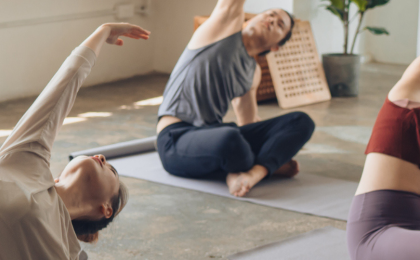
Healthy Living: Ways to Wellbeing; Meditation and Seated Yoga
Course details
Course code
Q00017016Course date
Number of classes
5 sessionsTimetable
Tutor
Georgia DanielFee range
How you'll learn
Venue
OnlineLevel of study
Entry Levels 1,2,3: If you have never studied this subject before and you’re not confident in your skills, Entry levels are a good starting point.
Level 1: Covers basic skills and knowledge needed for this subject
Level 2: Building on basic knowledge or experience. Similar to Grade 4/ C at GCSE or O level in England or Standards in Scotland.
Level 3: Learn about the topic in-depth and have a broad range of skills. Independent working Equivalent to an A level in England or Higher in Scotland.
Beginners: A perfect introduction if you have no experience and skills in this subject.
Improvers: The next step if you have basic skills or knowledge but want to progress them further.
Advanced: Build on the solid experience and skills you have in this subject, applying your skills and knowledge in a more complex way.
Course overview
Course description
Bring a chair, we will start with yoga followed by some deep mediation. Your tutor will encourage you to dim the lights and bring a blanket, a couple of cushions, dim the lights, maybe even light a candle with some incense sticks and simply lie down with the volume turned up and let go. After seated yoga you can begin meditation, you will be asked to lie on a bed, couch or floor with the eyes closed and the arms and legs in a completely relaxed. Hands should be relaxed and loose You will then be guided through a deep mediation where you may be walking on a sandy beach, watching the sun set. You may end up walking through a rain forest listening to the sounds of the jungle or maybe travel inside your own body in a bid to heal the any disease you may be experiencing.
This class is designed to reduce stress and tension in both the body and the mind. This beautiful practice helps with the following · Decreasing stress and anxiety · Improving sleeping problems · Increasing creativity and learning abilities · Improving cardiovascular health · Increased alertness Some weeks you may be asked to perform a scan of your body, focusing attention on different parts and releasing tension throughout. Slow breathing is encouraged throughout your Nida session. The practice often ends with visualizing calming images, such as a deep forest, the waves of the sea, or a green garden. Individuals are again encouraged to think about their Sankalpa. Following this, they are asked to slowly transition back into normal awareness by bringing some gentle movement back to the body.
-
What financial support is available?
-
We don't want anything to stand in your way when it comes to bringing Adult learning within reach so if you need anything to support you to achieve your goals then speak to one of our education experts during your enrolment journey. Most of our courses are government funded but if you don't qualify or need alternative financial help to access them then let us know.
-
What other support is available?
-
All of our digital content, teaching and learning activities and assessments are designed to be accessible so if you need any additional support you can discuss this with the education experts during your enrolment journey and we will do all we can to make sure you have optimal access.

